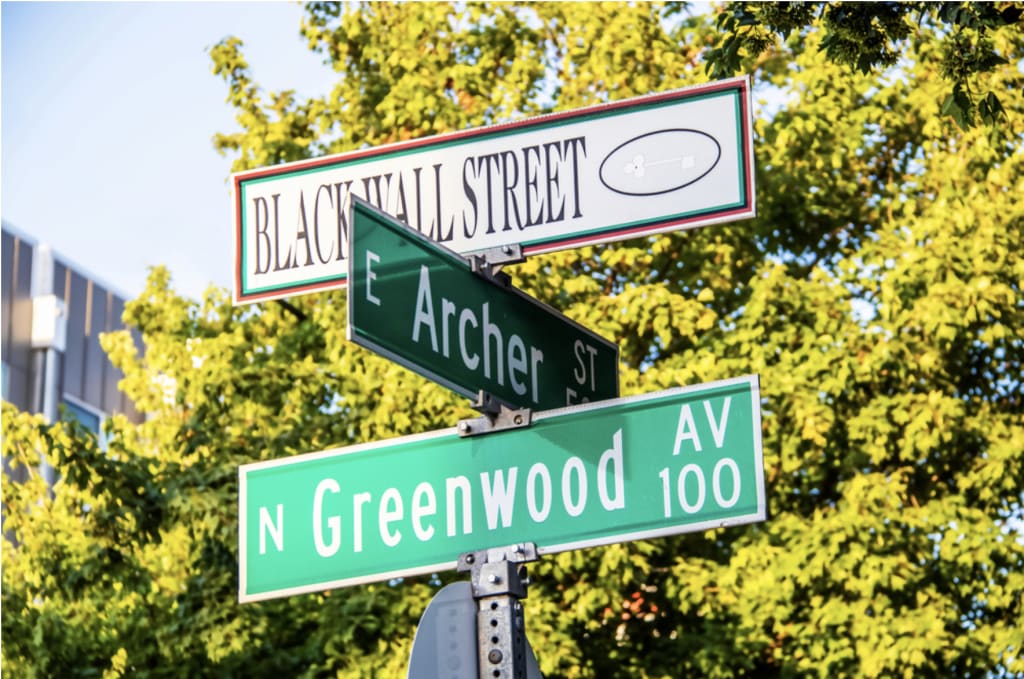Black Communities Beyond Black Wall Street
Communities during Jim Crow.

Throughout American history, Jim Crow laws and white supremacy limited the livelihood of Black Americans and left them with two options. They either could work as sharecroppers for their former slave masters or migrate from the South to Oklahoma. During the Trail of Tears, there was a land rush in Oklahoma. It was an opportunity for Black Americans to establish a community that empower them as a whole. In the early 1900s, Black Americans decided to move to Oklahoma to partake in the land rush and the oil boom.
Of course, nothing comes easy in life, especially for Black Americans under the law of Jim Crow and white supremacy. On December 18, 1907, there was a bill approved that enforced Jim Crow law of being “separate, but equal”. According to the Oklahoma Historical Society, “Senate Bill One, also known as the coach law and to most as the state's first Jim Crow law, easily sailed through Oklahoma's first legislature. The bill provided that ‘every railway company, urban or suburban car company, streetcar or interurban car or railway company . . . shall provide separate coaches or compartments as hereinafter provided for the accommodation of the white and negro races, which separate coaches or cars shall be equal in all points of comfort and convenience.” If the law was not enforced, there would be consequences. “The penalty for disobeying, ranged from one hundred to one thousand dollars for any company failing to provide separate facilities and from five to twenty-five dollars for any individual who, after being warned by the conductor, occupied any coach or compartment (including waiting rooms) not designated for his/her race. The bill authorized railroad officials to refuse service or eject violators.”
Consequently, there was backlash from Black Americans in Oklahoma. Some protests turned violent. However, it was temporary because on the rise, was a pioneer who would envision Black Americans on a pathway to economic enfranchisement and turn it into reality. That visionary was O. W. Gurley. Gurley was once known as the wealthiest man in Tulsa, Oklahoma. He was a wealthy African American landowner from Arkansas who traversed the United States to participate in the Oklahoma Land run of 1889. The young entrepreneur had just resigned from a presidential appointment under President Grover Cleveland in order to strike out on his own, according to Black Wall Street.
Before Senate Bill One was approved in 1907, Gurley moved to Tulsa where he purchased 40 acres of land which was "only to be sold to colored" in 1906. Gurley’s reasoning behind the purchase came about because black ownership was unheard of at that time. When Oklahoma enacted the bill, one might think that this would hinder Black Americans from obtaining land ownership and economic power. Nevertheless, the opposite became true when Black Americans migrated to Oklahoma as the Black Wall Street site reports, “Gurley’s property lines were Pine Street to the north, the Frisco rail tracks to the south, Lansing Avenue to the east and Cincinnati Avenue to the west. Among Gurley's first businesses was a rooming house which was located on a dusty trail near the railroad tracks. This road was given the name Greenwood Avenue, named for the city in Mississippi. The area became very popular among African American migrants fleeing the oppression in Mississippi. They would find refuge in Gurley's building, as the racial persecution from the south was non-existent on Greenwood Avenue.”
During this time, “the racial climate prevented Blacks from shopping anywhere but Greenwood. By 1913, more businesses followed, including law and doctors’ offices of Buck Colbert Franklin and A.C. Jackson respectfully, Dunbar and Booker T. Washington schools, Vernon AME, and Mount Zion Baptist churches, Ricketts’ Restaurant, The Williams’ Dreamland Theater, Mann’s Grocery Stores, Stradford Hotel, and a host of haberdasheries, drug stores, cafes, barbershops and beauty salons'' according to Black Wall Street website. This community was filled with Black wealth and historically known as Black Wall Street in Tulsa Oklahoma. Now, Black Wall Street was the not only established Black community. There were more than one community that Black Americans had established economic prosperity at the time, despite the lingering racism.
In North Carolina, a thriving Black community in Durham named Hayti was similar to Black Wall Street. Hayti was developed in the years following the Civil War where Black Americans had economic power. The objective for Black Americans was to work in tobacco factories at first after the abolishment of slavery. Previously, the land was rented by white merchants. Overtime, the land was taken over and it was bought as a commodity for economic power in the community.
According to the Open Durham website, “The success of the North Carolina Mutual Life Insurance Company and other African-American owned businesses created significant investment in the community, and the commercial buildings were upgraded to more sizable 1-3 story brick structures. Leading members of the community built large, architecturally impressive dwellings along Fayetteville St. The wealthier members of the community worked to establish civic assets such as a library and Lincoln Hospital.” Additionally, the website states, “NC Mutual created a land development company which developed much of the smaller rental housing on the side streets. The portion of the community north of White Rock Baptist, including the commercial structures along Pettigrew St., developed later and was evidently referred to as 'Mexico'. This was an area of more entertainment venues and restaurants, including some of the most prominent venues in Hayti - the Regal Theater, the Wonderland Theater, the Biltmore Hotel, and the Do-Nut Shop.”
Furthermore, between the years of 1888-1929, Richmond, Virginia was another black community that was successful during the Jim Crow era. Richmond was known as “The Cradle of Black Capitalism" addresses the following: “The Hippodrome Theater, opened in 1914 as a vaudeville and movie theater. It stands next door to a 26-room mansion, built in 1905 by the Rev. W.L. Taylor, a leader of the United Order of True Reformers, a temperance organization that was one of the largest black fraternal and business enterprises in the United States.” Another prominent figure in Richmond was Maggie Lena Walker. According to a Washington Post article, Walker was the daughter of a former slave, was a black entrepreneur and civil rights activist who achieved business success at about the same time as the more well-known Vanderbilts, Carnegies and other Northern captains of industry were making their names. “She was a respected resident of Richmond’s Jackson Ward neighborhood during the early 20th century, when the area was experiencing its heyday.”
It’s rare to see Black businesses that survived after desegregation from 1963 to the present time. Specifically, for those businesses struggling to rebound by revitalizing their business boom in the past. The Alabama Local News reported in an article in January 14, 2019 the following:
“Today, 50 years after the childrens' marches, fire hoses and bombings that moved a nation to adopt the Civil Rights Act, the black business district is a shadow of its former self. A row of businesses along the north side of Fourth Avenue is gone. Barbershops and restaurants line the south side of the street, most other retail long ago vanished. Only three merchants who were there in 1963 remain, according to merchants and development officials: Green Acres Café, the Magic City Barber Shop and Nelson Brothers Café.”
Unfortunately, not many people know about the significance of Black Wall Street, while others are hearing about it for the first time. Here's a tip: One thing about Black history or any subject of value, it's like digging for gold. Do not stop digging when nuggets are found, that is a sign to keep going. Who knows along the way you might become wealthy with invaluable knowledge.
About the Creator
Tyler Williams
A writer that empowers people through inspiring and informative articles.






Comments
There are no comments for this story
Be the first to respond and start the conversation.